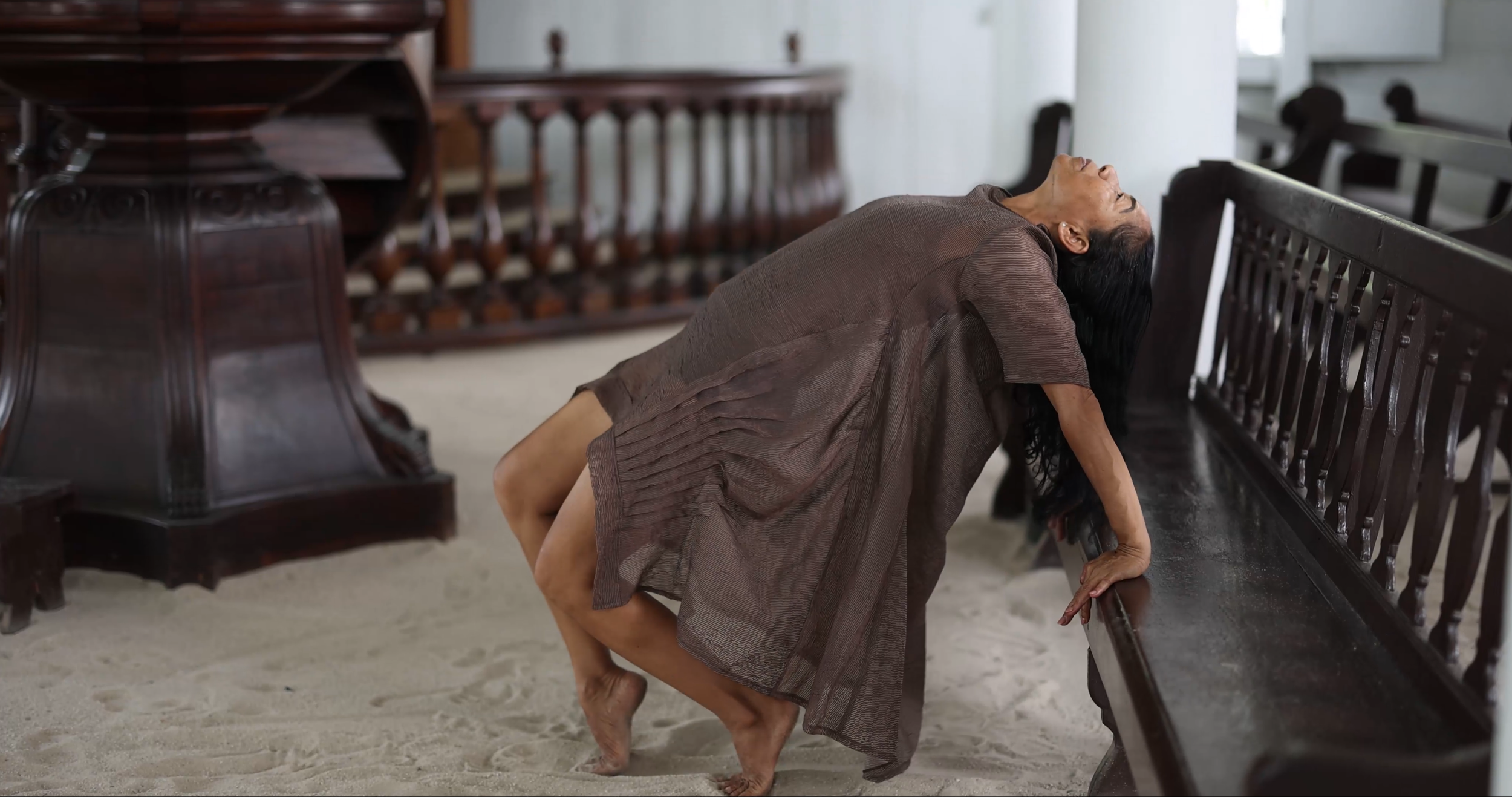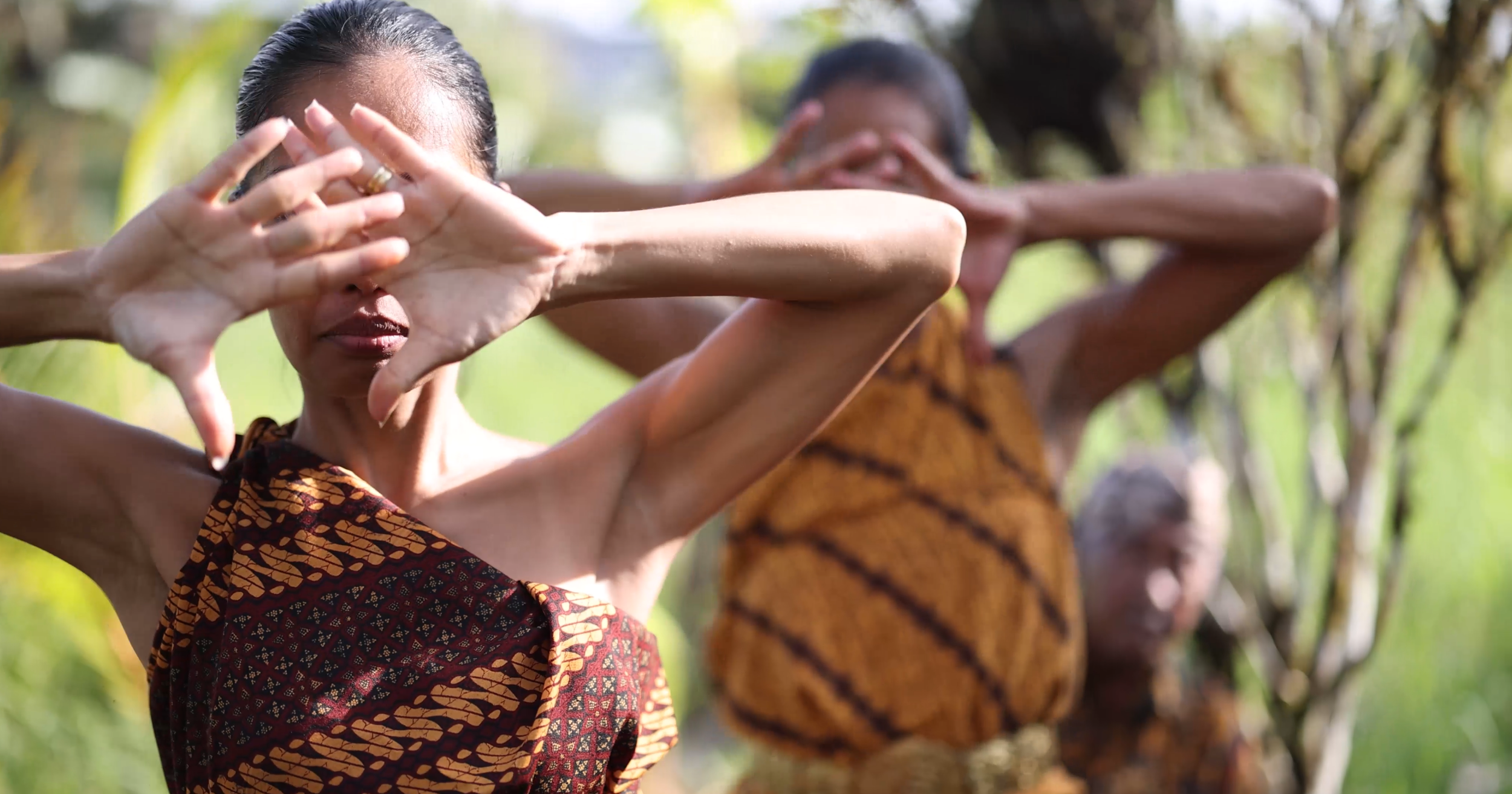KANKANTRI
In “KANKANTRI (The Silk Cotton Tree),” a woman is transported to the parallel universe of all her different ancestors where she dances and takes part in rituals until she feels whole.
PERSONAL CONNECTION
I revisited Suriname in 2000, thanks to a Guggenheim Fellowship, to research the African Diaspora dances of the country, including Winti. Towards the end of my stay, I visited The Neveh Shalom Synagogue for the first time, and I was overcome with emotion. I had chills all over my body. I didn’t know why. I felt so many things in that beautiful place. People said, “it must be the sand floor,” but I knew that wasn’t it, as we, in Curaçao, also have a Synagogue with a floor covered in sand.
When I got back to NYC, I called my dad and asked him about his father’s lineage. We already knew his mother’s lineage — my grandmother was half-Chinese and half-African, a mixed creole woman with the last name Ong-A Swie. We knew where in China her father was from and more. But we didn’t know the exact background of my grandfather… My dad told me he had some Jewish heritage, but he didn’t know much else. During the research period of this film, I found out that both my paternal grandparents were of Jewish descent, from the Levi family and the family Heilbron.
I’ve made three films prior to this one in this series called another building, and I actively tried to make this particular film for 10 years. This film was made possible thanks to funds from a Presidential Research Award from Barnard College, help from the ancestors, and the most wonderful team in Suriname.
If I had to categorize it, I would say this is an Essay Film (Art + Documentary). In many ways, it is autobiographic and reflects my experience of the spirituality in Suriname and my connection to my ancestors. Unlike the main character, I have “just” Chinese, African, Jewish, and Dutch backgrounds. Many people in Suriname have even more in their blood line from both sides of their family tree.
I hope you can take this journey and suspend logic.
— Gabri Christa, January 2024
“KANKANTRI is an intense film. I have often used the phrase ‘composite culture’ in my classes to describe what I believe to be the evolutionary process of all cultures and individuals therein. Yet, rarely do I witness this so well articulated, especially in a single work of art, until Gabri Christa’s film. A timeless and emotionally intense journey that simultaneously and seamlessly engages the intellect with echoes of Chimamanda Ngoni Adichie’s ‘The Danger of a Single Story,’ as well as Edward Said who, like Gabri, implores us to understand that the past lives in the present and that both are inextricably intertwined. This rhythmic and poetic visual tapestry evokes eternal questions and answers that one must relax into to receive. This film will be with me for a while.”
— Sheril Antonio, PhD Cinema Studies. Associate Arts Professor, Department of Art and Public Policy and Associate Dean of Strategic Initiatives, Tisch School of the Arts
KANKANTRI & SURINAME
Kankantri; (the silk cotton tree) scientific name Ceiba pentandra, is a tree that is considered to be holy in many countries in the Caribbean and Latin America, including in Suriname. This Giant of the Forest is believed to be inhabited by the ancestors. The tree stands tall all over Suriname and the Caribbean.
The film was created in Suriname (formerly Dutch Guyana) in South America, formerly a Dutch Colony, which was exchanged for New Amsterdam in 1667. The country borders Brazil and the two other Guyanas: French and British. Much of the country is part of the Amazon rainforest. It is often considered to be part of the Caribbean and also has an Atlantic coast.
Suriname was a slave society, and after the abolishment of Slavery, in 1863 (although the Dutch forced the the enslaved to keep working for another 10 years), the Dutch imported indentured labourers (contract workers), from three parts of the world: China, Indonesia, and India. The Indonesian people came mostly from Java. Many of the enslaved Africans fought for their freedom. Suriname has very large Marron society; they gained independence in 1700.



locations & histories in the film
The first location in the film, The Neve Shalom Synagogue in Paramaribo Suriname, is where dancer and main character Honore van Ommeren experiences the calls from all of her ancestors.
First, a Chinese ancestor places a jade stone in Honore’s hand. Second, her Javanese ancestor shares Javanese dances. Her Jewish ancestors arrive as well; in Suriname, the Jewish people are all mixed race.
A woman sings in her native language, Aukaans, (N’Djuka), and appears later in the film, dancing a traditional dance with some of the women of her Marron tribe, descendants of enslaved Africans in Suriname.
Her travels take her to Joden Savanne, the first settlement of the Jewish people in the new world. In September 2023, the site was named a World Heritage Site. In the film, the main character, is transported to the part furthest away from the river, where the creole and enslaved were buried.
We meet the Marron society in Santigron village, go on a magical boat ride in the swamps of Suriname, witness a ritual of Winti-Prey, and a traditional Ingi Wasi (Indigenous washing), an herb bath to cleanse and purify the spirit.
KANKANTRI: Screenings & Official Selections
Official Selections (2024/2025)
Cinedans Fest – Amsterdam, Netherlands (EYE Film Museum), 2024
Festival Videodanza de Puerto Rico – San Juan, Puerto Rico, 2024
Harlem International Film Festival – Harlem, NYC (Opening Film), 2024
Experimental Brazil – Rio de Janeiro, Brazil, 2024
Manifest Dance Film Festival – Pondicherry, India, 2024
Conch International Film Festival – Queens, NYC (Regal Cinemas) Winner: Best Experimental, 2024
Knowbox Dance Film Festival – Online & Live (Texas, Korea, Mexico) Audience Award: Best Film (Mexico), 2024
Inspired Dance Film Festival – Australia (Semi-Finalist), 2024
Fifth Wall FEST – Manila, Philippines Grand Jury Prize Winner, October 2024
American Dance Festival (ADF) Movies by Movers – North Carolina, USA, 2024
Frame x Frame Film Fest – Houston, TX, 2024
Screendance Miami – Miami, FL, January 2025
Dance Camera West – Los Angeles, CA Winner: Best International Short Film, 2025
Dance On Camera Festival – New York City, NY, 2025
Yeti Film Festival – Reykjavik, Iceland (Nominee: Best Dance or Poetic Film), 2025
PACE (Pan African Cultural Exchange) – Bloemfontein, South Africa, 2025
Invited Screenings & Special Events
New York University – Collaborative Arts, NY, 2025
Columbia University – Music Department, NY, 2025
Arthshila Art Center – Ahmedabad, India, 2025
W.I.P. Alt Festival – New Delhi & Bangalore, India, 2024
Under World Black Arts Festival – Detroit, USA, 2024
Theater Bellevue – Amsterdam, Netherlands (Keti Koti / Cinedans), 2024
Yale University – Invited Lecture & Screening (Film Studies), 2024
Kenyon College – Ohio (Work-in-Progress Screening), 2023
New Waves Festival – Barbados, 2024
BOOKING & CONTACt
To bring KANKANTRI to your film festival or screening or book a community engagement workshop, please contact Gabri Christa.
Credits
Writer, Director, Producer: Gabri Christa
Director of Photography and Editor: Steven Elbers
Producer: Ann Hermelijn
Starring: Honore van Ommeren
Composer: Mazz Swift
Sound Design and Sound Edit: Eve Cuyen
Assistant Producer, Sound recordist, and Driver: Chavelli Montsanto









